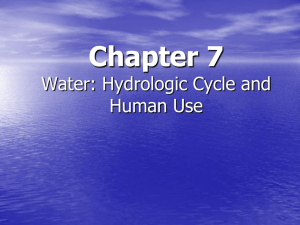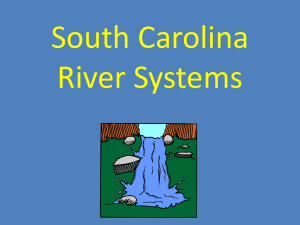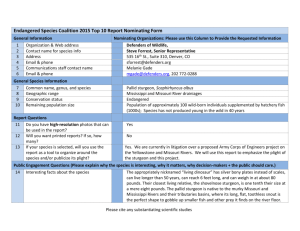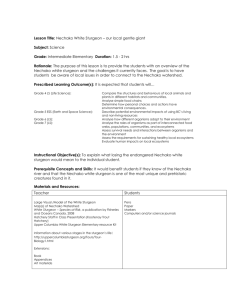Lecture Presentation
advertisement
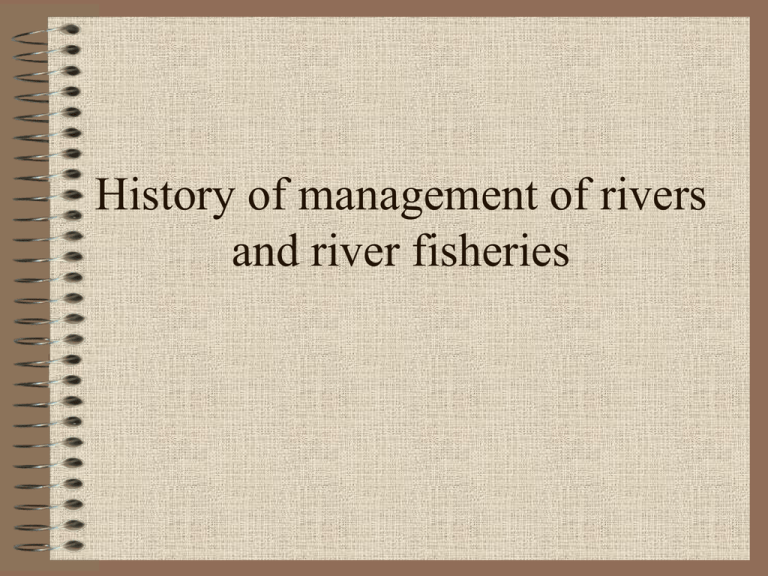
History of management of rivers and river fisheries History of Management • Definitions – River = “a relatively large natural stream of water” American Heritage dictionary – 1972 from River Ecology and Man “a fairly large, flowing body of water whose characteristics are largely determined by geology topography, soils and landuse of the watershed. – 1992 (Cummins) > 4th order catchment area = 10km2 Rivers Handbook (1994) • Rivers are 1) Three dimensional systems 2) Driven by hydrology and fluvial geomorphology 3) Structured by food webs 4) Characterized by spiraling processes, and 5) Dependent upon changing flows, moving sediments and shifting channels River management • Management-the act or practice of managing • Manage-to direct, control or handle; to administer or regulate; to make submissive • River management (Mellquist 1992) – Purpose and objectives: 1) balancing between users’ interests, 2) optimization of the use of resources, 3) inclusion of environmental interests and those of the public when exploiting water resources, 4) cleaning up after old sins. What we have: Native americans were our first river managers • Fish weirs and traps have been used for thousands of years by many native cultures Dams:early sins • By 1850’s most rivers in Colonies were dammed. • Deforestation and subsequent agricultural/industrial land use caused decreased water quality and finfish harvest. Worldwide river modification Dirty Father Thames *Pollution issues in Europe were mirrored in the colonies Successive appearance of pollution problems in countries according to their level and speed of development Rivers and Harbors Act 1824 • 1824 - Congress passes first "Roads and Canals" Act. Authorized Corps of Engineers to survey waterways to designate those "capable of sloop navigation" – Congress passes "An Act to Improve the Navigation of the Ohio and Mississippi Rivers." "to remove sand bars on the Ohio and planers, sawyers, and snags on the Mississippi" • Corps of Engineers has had responsibility for the waterways ever since. Ohio River • 1811 First steamboat appears. • 1828 Wing Dams constructed on the Kanawha River (a tributary). • 1837-1866 47 back-channel dikes and 111 training dikes were constructed in the Ohio R. • 1898 10 low-lift locks and dams completed in Kanawha R. • 1875-1900 Five low-lift L&Ds were constructed to provide a 2-m navigation channel. • 1900-1930 51 more were constructed between to provide a 2.75-m channel. • Since 1930 13 high-lift L&Ds have replaced the others. ACOE photo Mississippi and Illinois Rivers • Later but similar • 28 high L&Ds on the MS River beginning in about 1930 provided a 9’ channel. The MS is one of the most managed rivers in the US. Susquehanna River • North East-Susquehanna River=largest on Atlantic coast(drains 71,225 km2, 715 km mainstem). Provides 50% of the freshwater input into the Chesapeake bay. Not developed for navigation. • 1830-Canal dams were built; the last 72 km of the river was unimpounded (@Columbia, PA). • 1880’s-Canal system was abandoned because railroads were in. • 1904-York Haven dam was built @ km 88 (2-5 m high • 1910-17m high Holtwood Dam was completed @ km 40 and was barrier to fish migrations. $$$ paid for fish losses. • 1928-Conowingo Dam was completed. (29m @rkm16) • 1932-Safe Harbor Dam (53m @ rkm 51). • Largest Atlantic Coast Watershed • 50% of FW inflows to Chesapeake Bay • Not developed for Navigation • 448 miles long Conowingo Dam-Fish Lifts http://www.shwpc.com/fishlift.html Pacific North West • Columbia River-There are over 150 hydropower projects in the Columbia River Basin. • 1925 and 1927 Rivers and Harbors Acts call for power and navigation of the Columbia. • 1933-First dam completed on the Columbia; Rock Island Dam. • 1938 Bonneville goes on line (lowest on river). • 1941-Grand Coulee begins operation • 1967-Hells Canyon on line-blocking off Snake River. Closer to home-Alabama’s Rivers • KING COTTON-major commerce on the Alabama River. • 1818-The desent of the Coosa River began. • 1823 The Coosa Navigation Company was chartered by the AL legislature. A canal between the Hiawassee River, TN and the Coosa River was proposed. Example of magnitude of downstream commerce=in 1821 an estimated 12,000 gallons of whiskey was portaged from the TN river drainage to the Coosa. • 1864-Cummins Lay took the first steamboat Laura Moore down the Coosa river from Rome to Mobile during the Civil War. • 1866-Cummins Lay took the Laura Moore back up the Coosa during the 1866 spring rains. • 1872-Alabama River-Congress proposed “plan of improvement” • 1880-Congress authorized surveys of the Cahaba River. Commerce along the rivers • Trade was the major reason for initial developments • Special boats were made to navigate rapids • Upper Coosa (1842) • The “Dream” of CARIA has always been to navigate from Mobile to Rome, GA • Savannah River; similar history- 1850 cotton moved on Petersburg http://www.caria.org/timeline.html Boats King Cotton • • • • Mills Industry Towns Railroads Putting the Loafing Streams to Work • 1882-1892-A channel 1-m deep on the Cahaba R. was opened to Centerville. • 1882-the Tallapoosa was “improved” from forks to foot of Tallassee reef. • 1890-The Coosa-AL River Improvement Association was founded. • 1902-Montgomery Light and Water Power Company operated a 20ft dam/1200ft long that supplied power to the Capital. • 1907-William Patrick Lay (Cummins’ son) founded the Alabama Power Company. • 1911-James Mitchell was was attracted to the Tallapoosa River because it had groovy places to build hydropower dams. APCO the early days • 1911-Mitchell hooks up with Thomas Martin (a lawyer) • 1916-U.S. Supreme Court Case won by Alabama Power to develop the Tallapoosa “To gather the streams from waste and to draw from them energy, labor without brains, and to save mankind from toil that can be spared, is to supply what, next to intellect, is the very foundation of all our achievements and all our welfare” Justice Oliver Wendell Holmes on the 1916 Alabama Power Company vs. Mt. Vernon’s Lock #2 & Mitchell Dam APCO early philosophy • 1915,1920-Coosa River surveyed again. UAACOE recommends that the project be abandoned. • 1925-Martin Dam at Cherokee Bluffs was dedicated and the Alabama Power corporate philosophy was stated: • “The continued progress of our State, consists in lifting the burdens of drudgery from the shoulders of man to the tireless shoulders of the dynamo. Every loafing stream is loafing at the publics expense and every added kilowatt of power means less work for someone, more freedom, and a richer chance for life” Thomas Martin, President, Alabama Power Company Later Years • 1953-Alabama Power filed for multiple dams on Coosa. • 1960-A report indicated that the Coosa-Alabama had “no traffic of significance” • 1961-BIG FLOOD. Rivers at flood stage for 28 days. Main impetus for Alabama River Dams. • 1963-Millers Ferry started • 1969-Plans to construct the long awaited locks on the Coosa. • 1971-Tough water quality standards passed • 1978-Trouble with the locks. • 1982-Estimates were 1.3 billion and project abandoned • 1990-Attempts to stop dioxin pollution-ADEM= pro business • 1995-Mobile River Basin Coalition formed Riverine Fisheries • “The Mississippi will be one of the principle channels of future commerce for the country westward of the Allegheny...This river yields turtle of a peculiar kind, perch, trout, gar, pike, mullets, herrings, carp, spatula fish of fifty pound weight, catfish of on hundred pounds weight, buffalo fish and sturgeon” Thomas Jefferson “Notes on Virginia” Context • Definition of fishery-classic definition implies harvest. People/habitat/organisms • Finfish stocks were depleted for 3 reasons-WQ, fish passage and overexploitation. Fisheries were common property resources/owned by the entire populace. 1608=Dutch statesman Hugo Grotius established this concept with the freedom of the seas doctrine. • Supply > demand. Management’s goal is to regulate demand or increase supply. • Native Americans were first fishers. They regulated harvest/their population sizes were minuscule compared to colonists. • By the American revolution 100’s of laws were in place. Early agencies were NY 1868, CN 1870. 1871-US Fish Commission was established • Spencer F. Baird – First Commissioner – The Father of Fisheries Science - Brought Carp to NA - “Stock ‘til you drop • 1872- American shad to CA • 1879-Striped bass to CA; Fishery est. by 1889 River Fishes • • • • • • • Sturgeon Shad Salmonids Striped bass American eel Catastomids Mussels Sturgeons • Other GC rivers – 1896—fishers were sent to Suwannee R. – 1897—Levy Co. 9,254 lb worth $331 – 1917—Apalachicola R. and Bay; 20-60,000 lbs/year (red flags) – 1902 Mobile Bay— 100,000 lbs flesh ($3,930) and 5,000 lbs caviar ($2,000) • Tampa Bay – Site of 1st fishery for Gulf Sturgeon in Gulf of MEX (it lasted 3 years) Timing and gears used-Gulf Coast fishery • Suwannee R. 1 February-1 May • Apalachicola R. and Bay-Mid April-end June – 1957 Jim Woodruff dam stopped migrations – Gears included drifting gill nets, (through 1929 exclusively but in 1972 only accounted for 13% of the annual catch). – 1932 Pound nets and run around nets introduced in Suwannee – 1932 Trammel nets replaced above gears – 1945 Only trammel nets used – 1975 Only anchored gill nets were used • In 1988 commercial landings were 74 kg vs. early 1900’s at 170,078 kg. FL was the only state reporting commercial landings after 1964. Atlantic sturgeon • Acipenser oxyrinchus oxyrinchus Labrador to FL. • 1762--completely eliminated from the Exeter River, NH • 17th century--flesh, roe, oil and isinglass were exported in large quantities to Europe • 1850’s--sturgeon Flesh and roe were popular • 1890-- Delaware River and Bay supported 1,000 fishers and produced 2.27 million kg (~5 million lbs) • 1900-- harvest was reduced by 90%. • 1980’s--50-100,000 kg annually mostly in incidental groundfish trawls. • 1990--The Atlantic States Marine Fisheries Commission • 1992—100 individuals target species Pacific coast sturgeon • • • • • White sturgeon- Acipenser transmontanus 1889 Fishery began 1892 peaked 1899 stock was depleted size 1950 size restrictions Shad (Alosa) • 1896-Record landings on Atlantic Coast (50,500,000 lbs) • 1930’s-9-11 million lbs • 1979-2 million Susquehanna River-revisited • 1986-1994 numbers have increased 25 fold (from 3,500 to 86,000 fish) • 1983-84 a few hundred in fish lifts • 1991-92 over 25,000 • 1991 new fish lift online ($12 million) Restoration • CITES • ESA • Councils…



